WiFi-combine for hotels and workhorse for offices. Overview of access points Ruckus R500 / H500
Today we want to talk about the “modest” :-) solution of the Ruckus of the middle segment, namely, a pair of ZoneFlex R500 and ZoneFlex H500 points intended for building WiFi networks in offices and hotels, respectively. Suppose there are less spatial streams on these points and there is no support for Multi-User MIMO, but it is the middle class products that often turn out to be the best solution in terms of price / performance ratio.
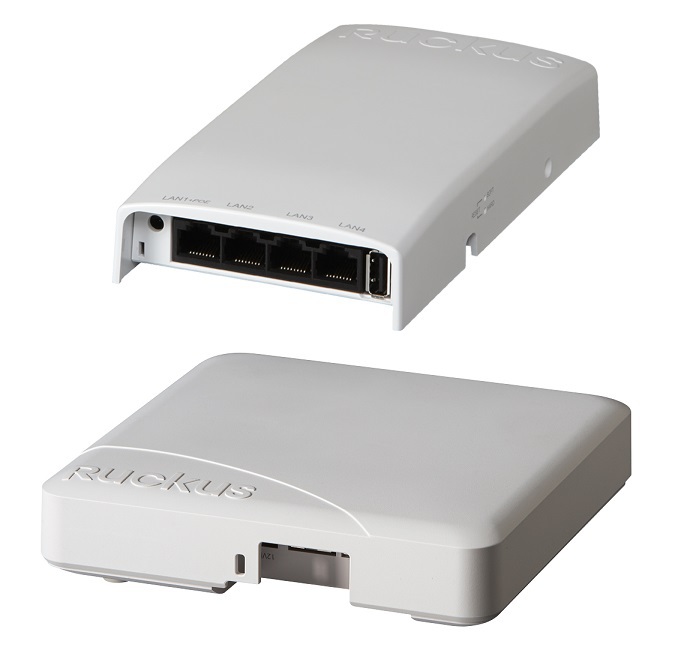
The ZoneFlex H500 and R500 access points are representatives of the first wave of the 802.11ac standard, compatible with all currently offered Ruckus controllers. These devices provide stable communication thanks to adaptive antenna systems. However, if the R500 is a universal solution, then the H500 is more specialized.
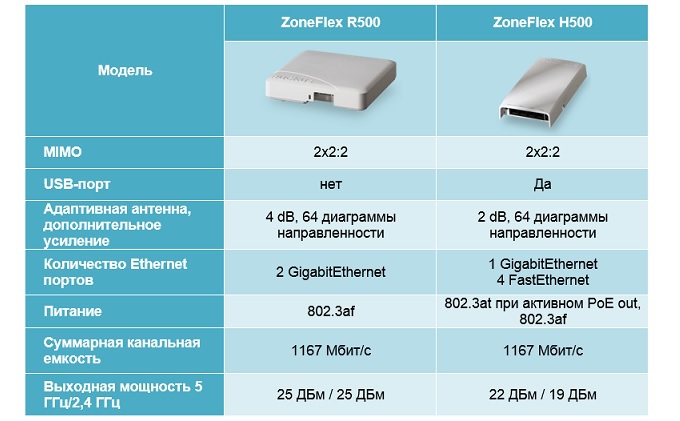
We see that the R500 has more transmitter power and a more efficient antenna system. The advantages of the H500 include a managed switch and the possibility of PoE Output. Actually, the H500 is positioned as an all-in-one solution, providing both radio access and cable network for the premises. For example, for a hotel room. This solution is particularly interesting in that it allows you to implement WiFi-access, IP-telephony, IPTV over a single twisted pair.

Converged wired and wireless services
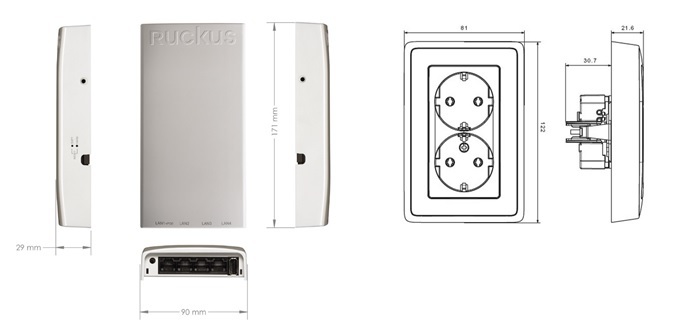
Similar envelope, but different contents

Two more views of the H500 device
As for the somewhat lower power, when installing an access point in each room, this is not a limitation, since even 18 dBm is sufficient for reliable communication in almost any multi-room room. But in this way it was possible to significantly reduce the size of the equipment, allowing it to be placed in place of a standard electrical outlet block.
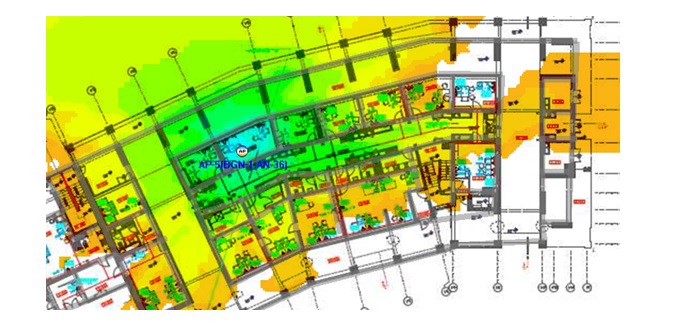

An example of a radio access point coverage with an antenna gain of 19 dBm in the 5 GHz band in a hotel complex
')
Also, unlike the R500, the H500 has a USB port in which you can place a Bluetooth adapter, for example, for precise positioning of customers and interaction with them. Scheme of the subscriber positioning system and geo-targeted information delivery:

Provision of geo-targeted services according to Qualcomm
And now we will conduct small field tests. Compare the ZoneFlex R500 access point with the ZoneFlex 7363 and the popular favorite of Ubiquiti Unifi UAP-Pro. Since it’s still optimistic to rely on the 802.11ac in all client devices, consider the option of a 2-channel 802.11n subscriber.

For radio planning, we take a typical office with plasterboard inner walls and an external capital reinforced concrete wall. Set the point (red circle) and measure in positions №1 - №5.
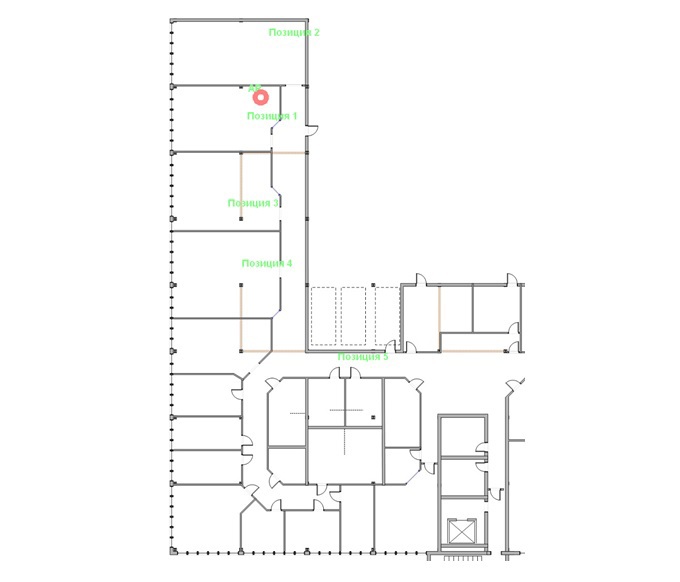
We get the following signal levels of access points:
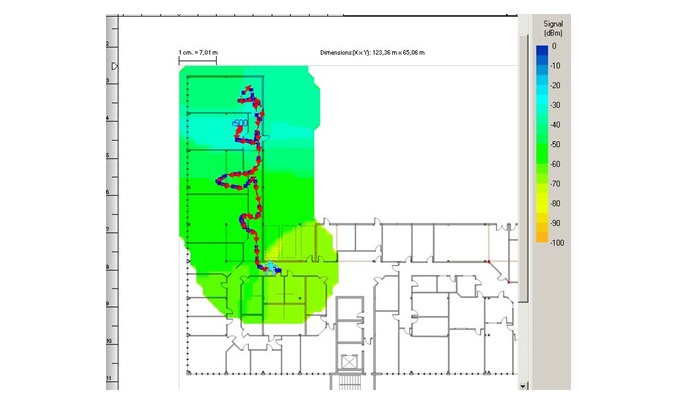
R500
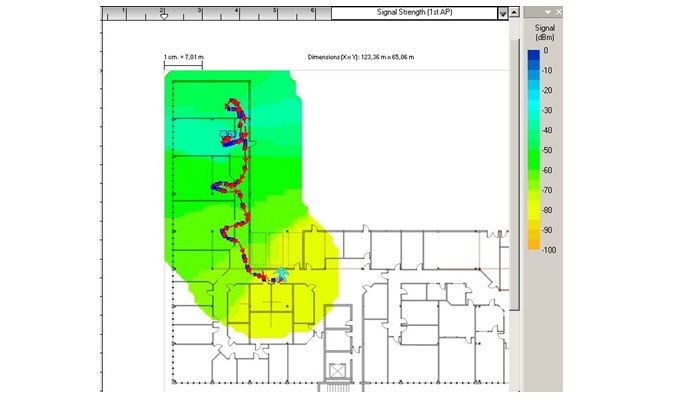
7363
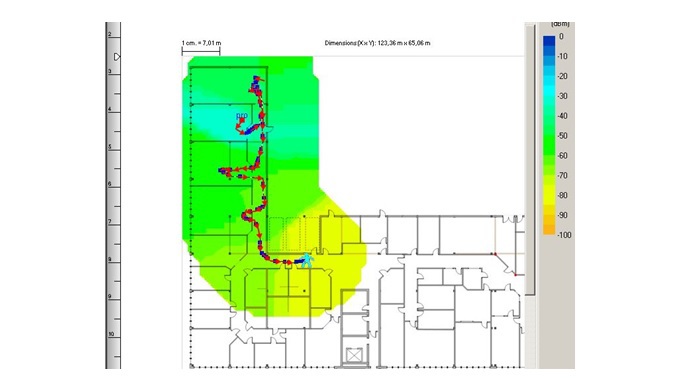
UAP PRO
We see that the adaptive antenna R500 allows you to get a significantly better signal level than the points of the previous generation or without an antenna with an adaptive radiation pattern at all.
To test the available capacity in practice, and not the maximum UDP performance, we will create 10-20 TCP sessions, that is quite typical, for opening a page or downloading several files. The IPERF traffic generator will help us in this. As a result, we obtain the following data:
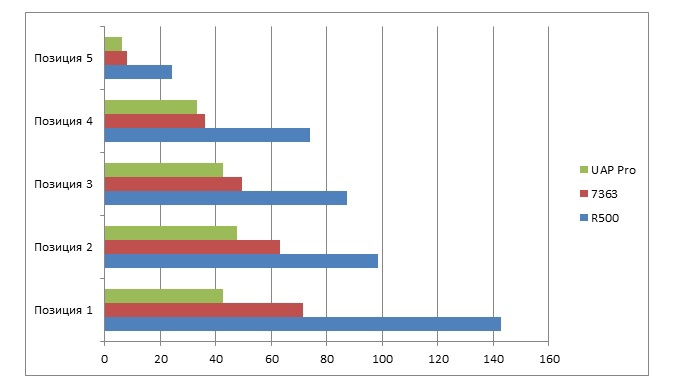
As can be seen from the graph, the access point of the R500 is the best, and the more complicated the conditions of signal propagation, for example, measurement position No. 5 around the corner of the concrete wall, the more significant its advantage. In general, its performance is 2-3 times higher than its rivals.
Findings:
Even when working with an 802.11n client device, the new generation of 500-series access points is significantly superior to low-cost 802.11n access points, as is the previous generation of Ruckus access points for useful performance and signal strength. Point H500 allows you to deploy a multiservice network without laying additional cables, install them compactly and without disturbing the appearance of the room.
We hope that these access points will give a good account of themselves in operation and allow Ruckus Wireless to continue their advance in the market. In conclusion, we present the biennial dynamics of the share of the market of access points of global manufacturers in the category of corporate and provider WiFi networks. As you can see, Ruckus consistently adds one percent per quarter. Which is quite good.

Data Synergy Research Group. Link to the source .

The ZoneFlex H500 and R500 access points are representatives of the first wave of the 802.11ac standard, compatible with all currently offered Ruckus controllers. These devices provide stable communication thanks to adaptive antenna systems. However, if the R500 is a universal solution, then the H500 is more specialized.

We see that the R500 has more transmitter power and a more efficient antenna system. The advantages of the H500 include a managed switch and the possibility of PoE Output. Actually, the H500 is positioned as an all-in-one solution, providing both radio access and cable network for the premises. For example, for a hotel room. This solution is particularly interesting in that it allows you to implement WiFi-access, IP-telephony, IPTV over a single twisted pair.

Converged wired and wireless services

Similar envelope, but different contents

Two more views of the H500 device
As for the somewhat lower power, when installing an access point in each room, this is not a limitation, since even 18 dBm is sufficient for reliable communication in almost any multi-room room. But in this way it was possible to significantly reduce the size of the equipment, allowing it to be placed in place of a standard electrical outlet block.


An example of a radio access point coverage with an antenna gain of 19 dBm in the 5 GHz band in a hotel complex
')
Also, unlike the R500, the H500 has a USB port in which you can place a Bluetooth adapter, for example, for precise positioning of customers and interaction with them. Scheme of the subscriber positioning system and geo-targeted information delivery:

Provision of geo-targeted services according to Qualcomm
And now we will conduct small field tests. Compare the ZoneFlex R500 access point with the ZoneFlex 7363 and the popular favorite of Ubiquiti Unifi UAP-Pro. Since it’s still optimistic to rely on the 802.11ac in all client devices, consider the option of a 2-channel 802.11n subscriber.

For radio planning, we take a typical office with plasterboard inner walls and an external capital reinforced concrete wall. Set the point (red circle) and measure in positions №1 - №5.

We get the following signal levels of access points:

R500

7363

UAP PRO
We see that the adaptive antenna R500 allows you to get a significantly better signal level than the points of the previous generation or without an antenna with an adaptive radiation pattern at all.
To test the available capacity in practice, and not the maximum UDP performance, we will create 10-20 TCP sessions, that is quite typical, for opening a page or downloading several files. The IPERF traffic generator will help us in this. As a result, we obtain the following data:

As can be seen from the graph, the access point of the R500 is the best, and the more complicated the conditions of signal propagation, for example, measurement position No. 5 around the corner of the concrete wall, the more significant its advantage. In general, its performance is 2-3 times higher than its rivals.
Findings:
Even when working with an 802.11n client device, the new generation of 500-series access points is significantly superior to low-cost 802.11n access points, as is the previous generation of Ruckus access points for useful performance and signal strength. Point H500 allows you to deploy a multiservice network without laying additional cables, install them compactly and without disturbing the appearance of the room.
We hope that these access points will give a good account of themselves in operation and allow Ruckus Wireless to continue their advance in the market. In conclusion, we present the biennial dynamics of the share of the market of access points of global manufacturers in the category of corporate and provider WiFi networks. As you can see, Ruckus consistently adds one percent per quarter. Which is quite good.

Data Synergy Research Group. Link to the source .
Source: https://habr.com/ru/post/265129/
All Articles